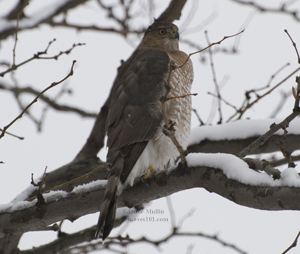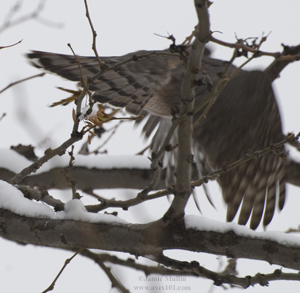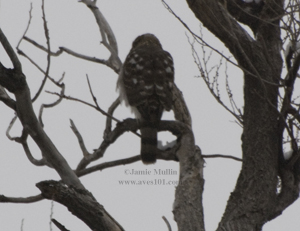Coopers Hawk
Order: Falconiformes
Family: Accipitridae
Genus: Accipiter
Species: cooperii
**Coopers Hawk audio comming soon**
Description
-
Length: 16.5"
-
Wing span: 31"
-
Weight: 1.0 lb (450 grams)
-
Medium sized hawk with a long barred tail
-
Tail is rounded & wings are also rounded but short
-
Darl gray or gray-brown back with abrred reddish and white underparts
-
Yellow legs, orange-red eyes with a white and gray banded tail
-
Sexes are silimar in plumage with females being larger
-
Juveniles are brown on back and wings with coarse brown streaks on underparts. Underwings are white with dark brown barring and may have white splotches on back. **Last 2 photos are a juvenile
Factoids:
-
A medium-sized hawk of the forest, the Cooper's Hawk specializes in eating birds. It is built for fast flight through the obstacle course of trees and limbs
- Dashing through vegetation to catch birds is a rather dangerous lifestyle. A recent study found that 23 percent of all Cooper's Hawks examined had healed fractures in the bones of the chest, especially of the furcula or wishbone
- A Cooper's Hawk captures a bird with its feet, and will squeeze it repeatedly to kill it. It does not bite the prey to kill it in the fashion of falcons, but holds it away from its body until it dies. It has been known to drown its prey, holding a bird under water until it stops moving
- Large numbers of Cooper's Hawks can be seen on migration, especially at hawk watches such as Hawk Mountain, Pennsylvania; Cape May, New Jersey, Goshute Mountain Range, Nevada, or Braddock Bay, New York. Autumn movements generally begin in late August and continue through early November. Young Cooper's Hawks tend to migrate about a week earlier than adults, and females tend to go earlier than males by a few days
- The Sharp-shinned Hawk is extremely similar to this species. The main difference is the size. A Sharp-shinned Hawk is roughly the size of a Magpie.
All photographs and audio clips are ©Jamie Mullin 2006
Sources: Cornell Lab of Ornithology & The Sibley Guide to Birds.
 |
|---|
 |
 |
 |
 |
 |